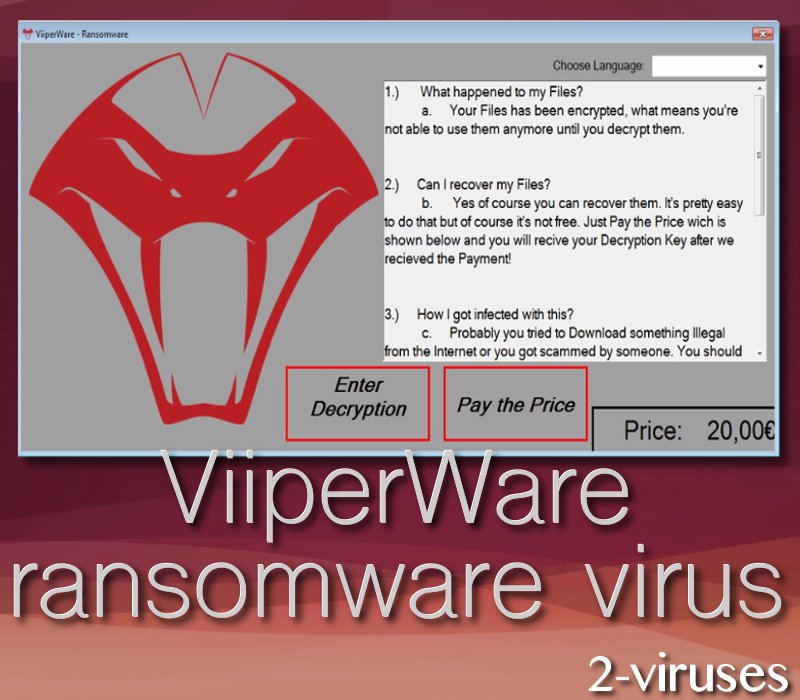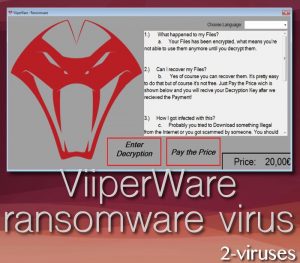ViiperWare ransomware virus is one of the freshest crypto-malware samples we can discuss and it demands a very small ransom for file encryption. Only 20 euros are required to be paid in exchange of recovery of files that have an extension of .viiper. Thinking practically, requiring smalls fees for decryption is not a dumb decision as it increases chances of victims actually paying them. Similar strategies have been noticed in ransomware viruses like CryptoDevil, but it is often that crypto-malware that require small ransoms are not usually designed very professionally.
Analysis of ViiperWare crypto-virus
This threat is delivered via a payload of ViiperWare-Ransomware.exe and it is based on HiddenTear open source project. It has managed to become an inspiration for a number of different infections like KillSwitch and Mordor. During a scan of the payload (VirusTotal scan), 47/66 security tools indicated it to be malicious. Some of the labels are as follows: Gen:Heur.Ransom.MSIL.1, Troj.W32.Generic!c, Trojan.Ransom.ViiperWare and Win.Trojan.Agent-6348474-0.

Most of the HiddenTear-based infections can be considered to still be in the process of development, meaning that they are not fully functioning. This has been noticed in infections like BlackMist which is also indicated to be still in-dev mode. ViiperWare Ransomware serves a screen-locker which prevents access to an operating system. Since the ransomware (A new threat of ransomware) is still in dev, we do not think that it will be able to pursue everything that it has prepared. It is crucial for a ransomware infection to be auto-executed after every reboot.
In the ransom note, victims of ViiperWare crypto-virus should be allowed to select a language in which they prefer to see the text. The message is similar to all of the other ransom messages we have seen. However, the screen-locker features a picture of a viper which is a venomous snake.
The virus also explains how the ransomware managed to slither inside victims’ operating systems. Hackers claim that users were involved in illegal activities or got scammed by unreliable third-parties and this explanation pretty much sums up the actual transmission methods (Ransomware Recap: Expanding Distribution Methods).
Decryption: is it possible?
ViiperWare virus is not threatening surfers at the moment, but it might start doing this anytime. If hackers improve their creation and it begins functioning as any other crypto-malware, then the situation will become more tricky. If there are any changes, we are sure to inform you about them as soon as possible.
For now, we shall observe the most common strategies that are applied for file-recovery. First of all, users that have stored their valuable digital files in backup storages have the advantage. If a ransomware invades your privacy, you won’t have to look for ways to restore executables. All you will have to do is remove the crypto-malware and retrieve files from a backup.
Other options include recovery of Shadow Volume Copies but ransomware infections have tendencies to get rid of these copies. Therefore, this file-recovery method is very frequently impossible. In addition to it, universal file-recovery tools can also be helpful.
Distribution and removal of ransomware
Ransomware viruses are very frequently transmitted in campaigns of malicious email letters. These messages usually include file attachments that hide malicious macros. Also, it is possible that malware will be installed after you visit a suspicious URL which was included in the disruptive email message.
To keep your device properly-secured, we are advising you look be cautious while surfing. Do not click on random ads, do not visit websites you had never encountered. Furthermore, keep an anti-malware tool installed for more protection. Spyhunter will help you clean devices whenever you see it. The device allows people to run scans on demand and we are sure that this feature is pretty much appreciated. Lastly, please backup your important digital files even if you just upload them into your USB flash drive.
Viiperware Virus quicklinks
- Analysis of ViiperWare crypto-virus
- Decryption: is it possible?
- Distribution and removal of ransomware
- Automatic Malware removal tools
- How to recover ViiperWare virus encrypted files and remove the virus
- Step 1. Restore system into last known good state using system restore
- 1. Reboot your computer to Safe Mode with Command Prompt:
- 2.Restore System files and settings.
- Step 4. Use Data Recovery programs to recover ViiperWare virus encrypted files

Automatic Malware removal tools
(Win)
Note: Spyhunter trial provides detection of parasites and assists in their removal for free. limited trial available, Terms of use, Privacy Policy, Uninstall Instructions,
(Mac)
Note: Combo Cleaner trial provides detection of parasites and assists in their removal for free. limited trial available, Terms of use, Privacy Policy, Uninstall Instructions, Refund Policy ,
How to recover ViiperWare virus encrypted files and remove the virus
Step 1. Restore system into last known good state using system restore
1. Reboot your computer to Safe Mode with Command Prompt:
for Windows 7 / Vista/ XP
- Start → Shutdown → Restart → OK.
- Press F8 key repeatedly until Advanced Boot Options window appears.
- Choose Safe Mode with Command Prompt.

for Windows 8 / 10
- Press Power at Windows login screen. Then press and hold Shift key and click Restart.

- Choose Troubleshoot → Advanced Options → Startup Settings and click Restart.
- When it loads, select Enable Safe Mode with Command Prompt from the list of Startup Settings.

2.Restore System files and settings.
- When Command Prompt mode loads, enter cd restore and press Enter.
- Then enter rstrui.exe and press Enter again.

- Click “Next” in the windows that appeared.

- Select one of the Restore Points that are available before ViiperWare virus has infiltrated to your system and then click “Next”.

- To start System restore click “Yes”.

Step 2. Complete removal of ViiperWare virus
After restoring your system, it is recommended to scan your computer with an anti-malware program, like Spyhunter and remove all malicious files related to ViiperWare virus. You can check other tools here.Step 3. Restore ViiperWare virus affected files using Shadow Volume Copies
If you do not use System Restore option on your operating system, there is a chance to use shadow copy snapshots. They store copies of your files that point of time when the system restore snapshot was created. Usually ViiperWare virus tries to delete all possible Shadow Volume Copies, so this methods may not work on all computers. However, it may fail to do so. Shadow Volume Copies are only available with Windows XP Service Pack 2, Windows Vista, Windows 7, and Windows 8. There are two ways to retrieve your files via Shadow Volume Copy. You can do it using native Windows Previous Versions or via Shadow Explorer. a) Native Windows Previous Versions Right-click on an encrypted file and select Properties → Previous versions tab. Now you will see all available copies of that particular file and the time when it was stored in a Shadow Volume Copy. Choose the version of the file you want to retrieve and click Copy if you want to save it to some directory of your own, or Restore if you want to replace existing, encrypted file. If you want to see the content of file first, just click Open.
b) Shadow Explorer It is a program that can be found online for free. You can download either a full or a portable version of Shadow Explorer. Open the program. On the left top corner select the drive where the file you are looking for is a stored. You will see all folders on that drive. To retrieve a whole folder, right-click on it and select “Export”. Then choose where you want it to be stored.

Step 4. Use Data Recovery programs to recover ViiperWare virus encrypted files
There are several data recovery programs that might recover encrypted files as well. This does not work in all cases but you can try this:- We suggest using another PC and connect the infected hard drive as slave. It is still possible to do this on infected PC though.
- Download a data recovery program.
- Install and scan for recently deleted files.








